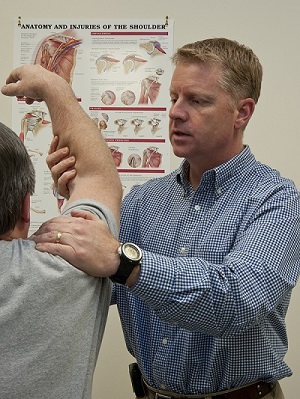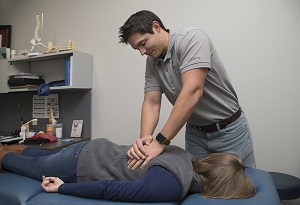Meet our physical therapists

Shoulders are common problem spots for physical therapy patients. Y-12 physical therapist Gary Hall examines the arm of a client.
Not many employers offer on-site physical therapy, so let’s meet the LiveWise physical therapists and physical therapist assistants who help improve the health of Pantexans and Y-12ers.
For Y-12 physical therapist Gary Hall, sitting for long periods should come with a Surgeon General’s warning.
“Sitting is the new smoking,” he said.
The American Physical Therapy Association acknowledges people’s sedentary tendencies. The organization focuses on the importance of physical activity and how physical therapy helps people to move.
According to the organization, inadequate physical activity adds $117 billion annually in health care costs in the United States and results in reduced quality of life for millions of Americans.
“We are more sedentary than we have been,” said Pantex physical therapist Cody McClary. “We’re not getting out as much. We’re not walking with the dog or the family. We’re not exercising the ways we should. Exercise helps our muscles stay strong and loose.”
One reason for the reduced activity is the COVID-19 pandemic. It has changed how people live, which includes how they work. Like many companies across the country, teleworking from home has become the norm at Pantex and Y-12. This means many hours sitting at a desk, kitchen counter, or dining room table, staring at a computer screen. Or in Hall’s case, on the couch.
“One day I was at home teleworking,” he recalled. “I’ve got my laptop, knees hunched up. My wife walked in and said, ‘It’s a good thing no one can see you right now.’ To say the least, I was not at optimal positioning.”
Slumped shoulders while seated for work is an example of improper positioning.
“When you sit at the computer, the head naturally migrates towards the monitor,” Hall explained, “which causes the shoulders to round over. You have to pull your shoulders back. This will help strengthen the muscles between the shoulder blades.”
Rounded shoulders can cause back issues, neck pain, and rotator cuff problems.
“More Pantexans ask about their wrists and hands,” McClary said. “They are feeling numbness and tingling, pain in the wrist. It’s because of bad ergonomics.”
To help alleviate discomfort from extended sitting, the prescription is to simply move.
“Take as many breaks as you can,” McClary suggested, “This will help get the blood flowing.”
He also recommended stretching to help relieve the body. For the hands, McClary likes to use stress putty, while making a fist, then extending the fingers. Also rubber bands can be placed around fingers to create resistance, strengthening them.
For the shoulders and back, McClary advocates the “field goal” stretch, where the hands are placed on each side of a doorway, while slightly shifting the weight forward. Also helpful are big and small shoulder circles, forward and back.
In addition to helping people deal with teleworking aches and pains, the physical therapists are helping with those recovering from COVID-19.
“Many are COVID long haulers,” Hall said. “The main problem is deconditioning. They find out they are unable to do certain activities when they try to go back to their normal work routines. Everything doesn’t return at the same rate. There’s weakness in the trunk and spine. They’ve lost strength in the peripheral muscles in the arms and legs. Some have lost the ability to maintain a posture to even type.”

Pantex physical therapist Cody McClary applies pressure to a patient’s back to help alleviate discomfort.
McClary added, “The heart and lungs were so stressed [during the bout with the virus], walking from the parking lot is extremely difficult. I’m sure we’re going to see more and more patients with these issues.”
Also, the therapists may experience a surge in seasonal patients.
“Fall is big for physical therapy clinics,” Hall said. “People are very task focused doing yardwork, like raking and bagging leaves, and they think ‘I have this entire yard of leaves; I need to take care of it today.’ A lot of times they don’t use the proper mechanics and may not have the proper core strength, which causes them to strain something and overuse muscles.”
McClary added, “Core strength is the most important aspect of your body. The core is the first group of muscles activated when you do anything. It really needs to be the strongest muscle group. A strong core protects the discs and the nerve structures around those discs in the back and can prevent injuries.”
In addition to tackling ailments due to teleworking, COVID-19, and weekend activities, the physical therapists treat post surgical patients who have undergone such procedures as knee and hip replacements, carpal tunnel surgery, heart surgery, and more.
“It can take six months to a year to recover from a surgery,” McClary said. “That could include three or four months of therapy, maybe even six months.”
Physical therapy is a free service for employees at both sites. However, a medical referral is required to receive treatment. All physical therapy evaluations and appointments must be on the employee’s own time.
“Working with people is very cool,” Hall said. “It’s really gratifying when you can help patients achieve their best.”
